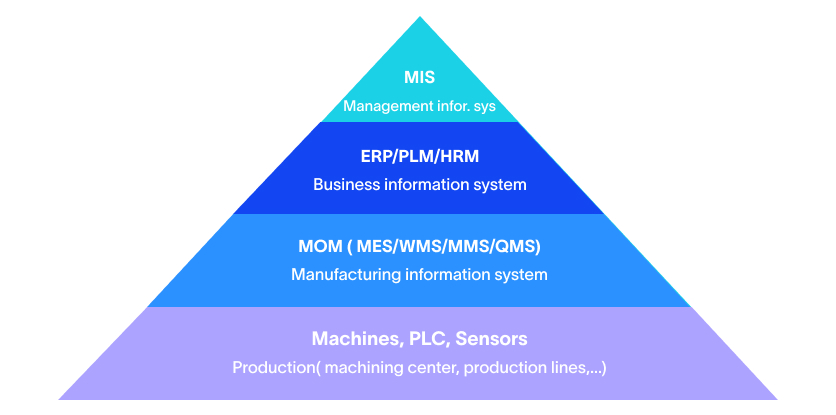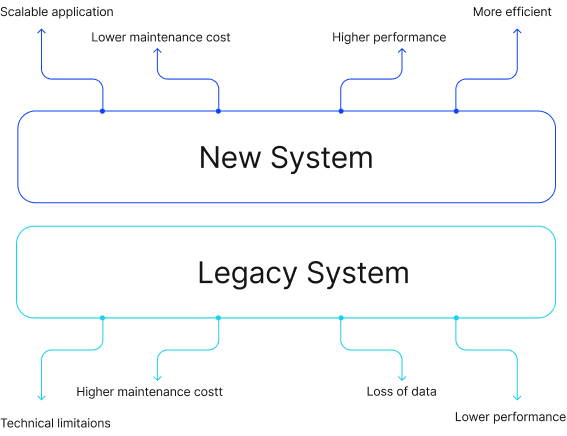Industrial Automation Software Should Evolve with You—Not Box You In
Blog
5 Min 10 Sec Read
When was the last time you questioned whether your industrial automation software is on par with your business?
Most manufacturers worry about downtime, disruptions, mounting costs, and training complexities when they think of automation. While disruption during automation is a possibility, shying away from automation causes other issues.
For example, when you hold on to the SCADA software or legacy automation systems for too long, it starts to box your business quietly into a limited boundary. This affects both efficiency and future growth.
At INS3, that journey starts with a simple yet powerful question: Should you upgrade, modernize, or replace the automation software? It should not force you into a rigid structure, hindering innovation.
In fact, we believe that the automation software you use for your manufacturing requirements should evolve with you seamlessly and not force you into a rigid structure that hinders innovation.
Should You Upgrade, Modernize, or Replace?
At INS3, we start with a focused, fast-track assessment to evaluate your existing automation systems. From there, we help you determine the right path forward:
Upgrade with Minimal Change
We focus on the best solution for your manufacturing process and accordingly upgrade industrial automation solutions with newer versions of software and hardware.
A common change here would be replacing the old Programmable Logic Controller (PLC) with a brand-new model while keeping the programming language and I/O wiring the same. An upgrade is the best solution for improving downtime and avoiding disruption in the process.
Modernize Flexibility and Scalability
Sometimes, the SCADA software requires modernizing the old tech and software that’s slowing down your manufacturing process. This process involves adding Industrial Internet of Things (IIoT) features or adding analytics tools and sensors to improve performance.
Beyond efficiency, how does SCADA integration impact predictive maintenance? Find out in our detailed analysis
Replace Legacy SCADA
INS3 also helps you determine if your industrial automation solution demands a complete overhaul or not. This process involves redesigning the entire system and implementing it at an organizational level.
No matter your current state, we help you build a roadmap for modernization and move down the path of digital transformation, without disrupting production.
Why Now? New Demands Are Stretching Old Systems
The status quo for manufacturers is no longer enough to stay ahead of the competitive industry. Manufacturers face different, relentless challenges.
Labor Shortage
One of the biggest challenges is the labor shortage. Manufacturers are struggling to maintain operations and institutional knowledge. This shortage is affecting the production cost, delays in production, and potential knowledge loss as experienced employees retire without proper knowledge transfer.
Process complexity
Process complexity is reaching a level that’s almost impossible for a legacy control system to work on. Organizations are facing difficulty in maintaining responsiveness, efficiency of production, and keeping basic manufacturing functionality at an optimum level.
While initially designed for specific tasks, legacy systems lack the flexibility and skills needed for today’s dynamic interconnected environments.
Cybersecurity concerns
Industrial architectures nowadays are heavily modernized and integrated into a single cloud-based digitized network. It’s difficult to maintain a high level of industrial security with outdated systems working disparately. A robust and interconnected network is essential for industrial automation solutions to work efficiently.
Industry 4.0 technologies
Furthermore, old industrial automation servicess don’t include the upgrade to Industry 4.0 technologies. Tools like automation, data exchange, and IIoT are must-have features for automation systems at manufacturing companies.
Basic automation is no longer enough to stay competitive in the modern world of technology and the competitive market of the manufacturing industry. When we talk about industrial automation solutions, not boxing you in, we mean empowering your manufacturing team with more data, tools, and real-time insights, and predictive maintenance to build, secure, and maintain a scalable platform.
Tired of costly downtime crippling your productivity? Discover how AI and predictive analytics can be your ultimate solution.
What to Look for in Modern Industrial Automation Services
Manufacturing leaders who want to innovate and not stay stagnant within their old manufacturing process must resort to modern industrial automation services. It should evolve alongside the operations and never restrict your potential.
The modern future-ready solutions take the manufacturing process to a different level with smarter decisions, and so on. The following are some common upgrades from old automation solutions manufacturing companies have been using.
Visibility in Real-Time
Drive smarter decisions by seeing equipment and process performance. This should help you make better and smarter decisions.
Seamless Integrations
A truly connected plan that’s supported by multiple innovative tech features like IIoT, AR, and additive manufacturing is the goal on the horizon for updated and innovative manufacturing companies.
AI-powered Predictive Maintenance
A critical focus must be on leveraging Industry 4.0 technologies. When choosing industrial automation tools, manufacturers and businesses must go for AI-powered maintenance tools that provide real-time insights about manufacturing.
Digital twin manufacturing is improving the way manufacturers carry out their manufacturing process. Provide unified, structured, and context-rich data to leverage the power of AI and twin manufacturing.
Robust security
Cyber threats affect the manufacturing process, cause production delays, and disrupt the supply chain, affecting a business on a larger scale.
But, with industrial automation solutions embracing new technologies like a comprehensive IIoT strategy. Manufacturing hubs that are ahead of the curve are adopting this strategy, not as a luxury, but as an essential means to defend against evolving cyber threats.
Flexible, Scalable Architecture
It’s critical to adapt to the changing production demands. That’s why, when implementing an industrial automation system, manufacturing companies must create flexible and scalable automation structures. The base of the architecture should always be easy to upgrade, modify, and improve without disrupting the existing process.
If your current automation or SCADA platform can’t deliver these benefits—or locks, you into an aging ecosystem—it’s time to consider your options.
Learn how SCADA Security Protects Your Industrial Control Systems from Cyber Threats
How INS3 Helps You Modernize with Confidence
As manufacturing companies, it’s important to have the agility to upgrade to modern solutions and avoid risky situations. At INS3, we help you upgrade, modify, and implement with confidence, without putting your team through an overwhelming overhaul process.
- No-risk assessment: We provide a comprehensive, expert evaluation of your existing automation landscape, identifying risks, bottlenecks, and opportunities.
- Practical, phased modernization: Choose the right strategy, whether it’s an upgrade, a targeted modernization, or a full replacement. We guide you through each phase, minimizing disruption.
- Seamless SCADA upgrades or replacement: INS3 leverages proven industrial automation solutions, applying open standards and future-ready architectures.
- Advanced technical expertise: Our team is fluent in OPC UA, MQTT, SQL, industrial networking, and IIoT protocols, ensuring interoperability with existing and future systems.
- Support for transformative use cases: Once foundational systems are modernized, we help you unlock high-value applications like predictive maintenance, digital twin manufacturing, and smart factory implementation.
INS3 meets you where you are today and helps build the foundation for where you need to go tomorrow.
Take the First Step: Complimentary Workshop and Readiness Study
Every digital transformation journey begins with a clear understanding of your plant’s current state and potential. INS3’s complimentary plant readiness workshop and modernization study provides:
- An objective evaluation of your current SCADA and automation software.
- Identification of quick wins and longer-term opportunities for upgrading or replacement.
- A step-by-step roadmap for smart factory implementation—including integration of IIoT devices and Industry 4.0 technologies.
- Tailored recommendations to strengthen your industrial IoT security strategy.
- Preparation for advanced applications such as predictive analytics, asset optimization, and digital twin solutions.
Let’s talk. With INS3, you’ll gain clarity and a concrete plan, without risk or disruption to ongoing operations.
Modernization Doesn’t Wait—Neither Should You
Industrial automation solutions are the core foundations of today’s manufacturing companies. A weak and outdated foundation affects the quality, productivity, and overall security and competitiveness of your manufacturing hub.
But it’s possible to avoid production delays, supply chain disruptions and reduce repeat clients with modern versions of industrial automation solutions. With pressures mounting from every angle (talent shortages, cyber threats, rising complexity, and digital transformation expectations), the status quo isn’t just holding you back—it’s putting your future at risk.
The updated and right digital transformation solutions help solve talent shortages, rising complexity, and cyber threats at a rapid pace.
Ready to discover the transformative value of implementing better automation software solutions? In that case, contact INS3 to schedule your complimentary plant readiness workshop. We helped a mid-sized plant modernize its automation to support predictive maintenance and digital twin initiatives without disrupting production.

Agile MES: The Key to Unlocking Smart Manufacturing Success
MES is a computerized system used in manufacturing operations to track and document the transformation of raw materials into finished goods. An MES system typically manages and monitors work orders, equipment, materials, and personnel on the shop floor. The system provides real-time visibility into production processes, helps optimize manufacturing operations, and improves the overall efficiency of the manufacturing process.

Understanding OEE: The Key to Manufacturing Efficiency
In today’s competitive manufacturing landscape, improving efficiency and productivity is crucial for businesses to remain competitive. One of the key metrics used to measure manufacturing efficiency is OEE or Overall Equipment Effectiveness. In this blog, we will take a closer look at OEE and its importance in manufacturing.

How to Effectively Conduct a Legacy System Integration
Legacy system integration can be a daunting task, but it’s a necessary one for many manufacturers that rely on outdated systems to run their business. Integrating legacy systems with modern technology can improve efficiency, streamline processes, and save time and money. However, it’s important to approach the integration process carefully and methodically to ensure success.
Share on :
Keep On Reading
Subscribe to Our Newsletter
Subscribe to our weekly newsletters to get updates regarding our new production, behind the scene process of our art creation and much more.
After submitting this form you will receive an e-mail with a confirmation link that you must click to complete your request. Detailed information on processing and cancellation can be found in our privacy policy.

